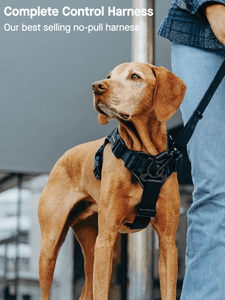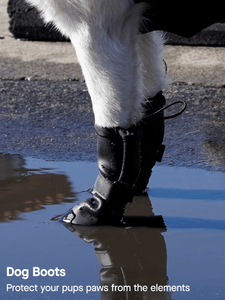Return to Blog
How to Introduce Your Dog to Rain Boots: Tips and Tricks
By Jackie Serpe on Sep 23, 2024
Introducing rain boots to your dog may seem like a daunting task. Dogs often resist new things, and rain boots are no exception. However, with patience and the right approach, you can help your dog grow comfortable with wearing them. Tips for introducing your dog to rain boots include starting with short periods of wear, using positive reinforcement, and gradually increasing the duration as your dog becomes more accustomed to them. In this article, we will also explore how to select the right rain boots, how to get your dog used to them, and how to make wearing rain boots a regular part of your dog's routine. We'll also discuss common issues and solutions to ensure a smooth and positive experience for both you and your pup.
Check out our blog on the benefits of dog rain boots.
Choosing the Right Rain Boots for Your Dog
Size and Fit: Finding the Perfect Pair
Getting the right size dog rain boots is super important. Measure your dog's paws when they're standing. Use a ruler to check the width and length of each paw. Don't forget to measure all four paws, as they might be different sizes. Compare these measurements to our size charts on site.
Material Matters: Durability and Comfort
The material of dog rain boots is crucial for both comfort and durability. Rubber is a popular choice for its waterproof qualities. It keeps paws dry on rainy walks.
Design and Functionality: Beyond Aesthetics
Good dog rain boots do more than look cute. They should have non-slip soles for traction on wet surfaces. This helps prevent slips and falls during rainy walks. Look for boots with reflective strips or bright colors. These make your dog more visible in low light conditions. The Waterproof Rain Boots at Canada Pooch come in bright colours for visibilty.
Getting Your Dog Used to Rain Boots
Introducing Rain Boots in a Positive Way
Start slow when introducing dog rain boots. Let your dog sniff and investigate the boots first. Don't force them on right away. Place treats near the boots to create positive associations. This helps your dog see the boots as something good, not scary.
Try putting the boots on for short periods at home. Use lots of praise and treats during this time. Keep sessions brief and fun. If your dog seems stressed, take a break. It's important not to rush the process.
Training Your Dog to Wear Boots
Once your dog is comfortable around the boots, start the actual training. Begin with just one boot on one front leg. Let your dog walk around the house like this. They might walk funny at first. That's normal. Encourage movement with treats and praise.
Gradually increase the time your dog wears the boot. Then add a second boot on the other front leg. Once they're okay with front boots, add the back ones. Always watch for signs of distress. If your dog seems upset, go back a step in the process.
Dealing with Initial Discomfort
It's common for dogs to feel awkward in boots at first. They might lift their paws high or refuse to move. This is normal. Don't force your dog to walk. Instead, distract them with toys or treats. This can help them forget about the strange feeling on their feet.
If your dog tries to remove the boots, redirect their attention. Offer a favorite toy or start a game. The goal is to make wearing boots more fun than trying to take them off. Some dogs adjust quicker if you use baby socks under the boots. This can make the feeling less strange.
Making Rain Boots a Regular Routine
Getting your dog used to rain boots takes time and patience. Start by putting the boots on for short periods inside the house. Gradually increase the time your dog wears them. Give lots of treats and praise when your dog has the boots on. This helps create a positive association with the boots. Soon, your pup will see the boots as a normal part of walkies.
Once your dog is comfortable wearing the boots indoors, it's time to venture outside. Start with short walks around the yard or block. Keep an eye on your dog's gait and comfort level. If your dog seems unsure, offer encouragement and treats. Slowly increase the length of your walks as your dog gets more confident in the boots. Remember, every dog is different, so be patient and go at your pup's pace.
Integrating Rain Boots into Everyday Walks
To make rain boots a regular part of your dog's routine, consistency is key. Put the boots on for every rainy walk, even if it's just a quick potty break. This helps your dog understand that boots are part of rainy day outings. If your dog resists at first, be patient and offer lots of praise and treats. The more you stick to the routine, the easier it will become.
Consider using the boots on muddy days too, not just rainy ones. This expands their usefulness and gives your dog more practice wearing them. It also keeps your pup's paws clean and dry in various weather conditions. Remember, the goal is to make the boots feel like a normal part of going for a walk, just like putting on a leash.
Understanding Behavioural Signs and Acting Accordingly
Watch your dog closely when wearing rain boots. Look for signs of discomfort or stress. These might include refusing to walk, trying to shake off the boots, or walking strangely. If you notice these signs, check the fit of the boots. They might be too tight or loose. Sometimes, a simple adjustment can make a big difference in your dog's comfort level.
Pay attention to your dog's body language. A relaxed, happy dog will walk normally and show interest in their surroundings. If your dog seems tense or unhappy, take a break. Remove the boots and let your dog's paws rest. It's okay to take things slow. Remember, the goal is to make rainy walks enjoyable, not stressful.
Common Problems and Solutions When Using Dog Rain Boots
Addressing Fit Issues
Proper fit is crucial for your dog's comfort and the effectiveness of the rain boots. If the boots are too tight, they can potentially cause discomfort. Signs of tight boots include your dog limping or refusing to put weight on their paws. On the other hand, boots that are too loose can cause chafing or fall off easily. Watch for signs of rubbing or boots twisting on your dog's legs.
To ensure a good fit, measure your dog's paws carefully before buying boots. Pay attention to both the width and length of the paw. When trying on boots, make sure your dog can spread their toes inside the boot. There should be a little wiggle room, but not so much that the boot slips around.
Resistance and Anxiety: Techniques to Combat Fear
Some dogs may show fear or anxiety when it comes to wearing rain boots. This is often due to the unfamiliar sensation on their paws. To help your dog overcome this fear, start with very short boot-wearing sessions. Put the boots on, give lots of treats and praise, then take them off. Repeat this several times a day, gradually increasing the time the boots stay on.
Use positive reinforcement to create good associations with the boots. Every time you bring out the boots, make it a fun and exciting event. Use high-value treats that your dog only gets when the boots come out. Play your dog's favorite games while they're wearing the boots. This helps shift their focus from the strange feeling on their feet to the fun they're having.
Handling and Storing Boots to Maximize Lifespan
Proper handling and storage of your dog's rain boots can significantly extend their lifespan. After each use, clean the boots thoroughly.
Allow the boots to air dry completely before storing them. Don't use direct heat sources like radiators or hairdryers, as this can damage the material. Once dry, stuff the boots with paper to help them keep their shape. Store them in a cool, dry place away from direct sunlight. Avoid storing them in plastic bags, which can trap moisture and lead to mold growth.


